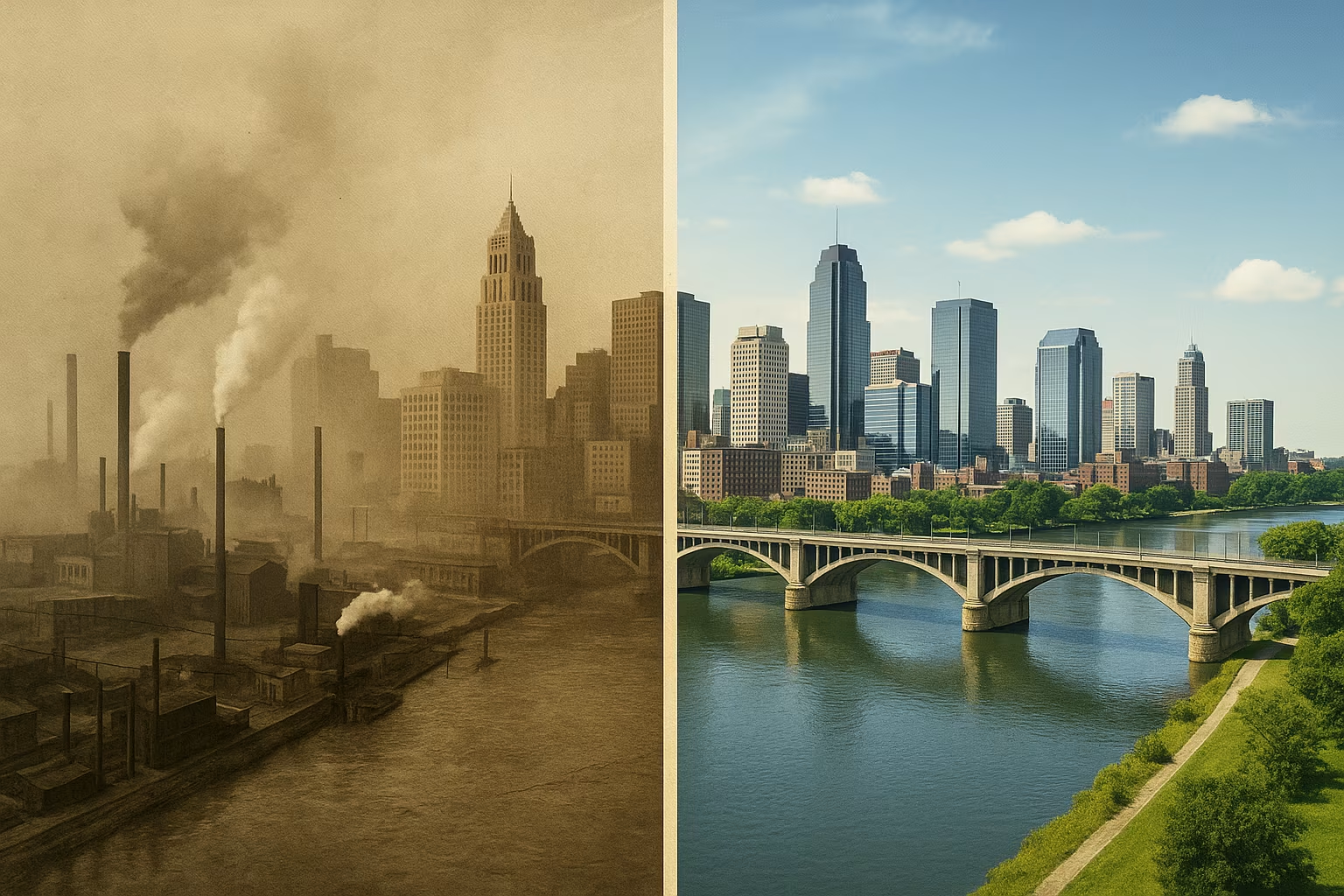In the 1960s and early 1970s, many American cities looked drastically different from the clean, regulated environments we know today. Smog shrouded skylines, industrial smoke poured from unfiltered stacks, and rivers ran black with chemical waste. Before the Environmental Protection Agency (EPA) was established in 1970, there were few national laws to curb air and water pollution — and industries often discharged waste without consequence.
Vintage photographs from that era offer a sobering glimpse into what life was like when environmental protections were minimal, and public health bore the cost of unchecked industrial growth.
1. Skies Choked with Smog
In cities like Los Angeles, Pittsburgh, and Gary, Indiana, smog was a daily reality. Photographs show skylines almost disappearing into thick, yellowish haze. The air wasn’t just unpleasant to look at — it was hazardous to breathe.
In the late 1960s, Los Angeles often recorded air pollution levels so high that schools would keep children indoors for “smog days.” Pittsburgh, once known as “The Smoky City,” had entire neighborhoods coated in soot from steel mills, forcing residents to clean their homes and clothes almost daily.
2. Rivers That Caught Fire
Perhaps nothing illustrates the pre-EPA era better than the infamous Cuyahoga River fires in Cleveland, Ohio. For decades, chemical waste and oil slicks had been dumped directly into the river, turning it into a flammable hazard. A now-iconic photograph from 1969 shows fireboats dousing flames on the water’s surface.
Other waterways were similarly degraded. The Hudson River was a dumping ground for industrial chemicals like PCBs, and the Potomac River in Washington, D.C., was so polluted that fish kills were common.
3. Urban Neighborhoods Next to Toxic Plants
Before environmental zoning laws, factories and refineries often operated right next to residential neighborhoods. In Newark, New Jersey, and East Chicago, Indiana, vintage images show smokestacks looming over rows of houses. Residents lived with constant exposure to airborne chemicals, while paint, laundry, and even gardens were coated with industrial residue.
Children played in yards just blocks away from facilities releasing lead, mercury, and other toxins — long before the health consequences of such exposure were widely acknowledged.
4. Beaches Closed and Lakes Contaminated
It wasn’t only urban areas that suffered. Popular beaches along the Great Lakes were frequently closed due to high bacterial contamination levels, visible in photos showing warning signs and empty shorelines. Lake Erie, in particular, was declared “dead” by the late 1960s because algal blooms — fueled by sewage and fertilizer runoff — had depleted oxygen and killed most aquatic life.
In coastal cities like Boston, untreated sewage was routinely discharged into the ocean, leaving nearby beaches littered with waste and unsafe for swimming.
5. Airborne Pollution from Coal and Oil
Vintage images from the Appalachian coal region and industrial Midwest show entire towns blanketed in coal dust. Refineries along the Gulf Coast spewed plumes of dark smoke into the air, often without any filtration systems.
In some photographs, midday skies appear darker than twilight because of particulate matter. Studies from that era revealed elevated rates of asthma, lung disease, and other respiratory illnesses in these communities, although the connection between pollution and public health was only starting to gain attention.
6. The Turning Point: Public Outcry and Political Action
By the late 1960s, public awareness was rising. Photographs of oil-covered beaches after the 1969 Santa Barbara oil spill and images of burning rivers began appearing on front pages across the country. Environmental activism grew, and groups began demanding federal action.
This momentum culminated in the creation of the Environmental Protection Agency in 1970, under President Richard Nixon. The EPA’s mandate was to set and enforce standards for clean air and water, regulate waste disposal, and research environmental health.
7. The Before-and-After Contrast
Comparing vintage photographs from before and after the EPA’s regulations is striking. In Los Angeles, for example, modern-day skyline shots show significantly clearer air, thanks to emissions standards for vehicles and industrial plants.
Rivers like the Potomac and Hudson have undergone significant cleanups, with recreational fishing and boating now common. Lake Erie, once a symbol of environmental collapse, supports thriving tourism and sport fishing industries.
This progress underscores how transformative policy and enforcement can be — but it also serves as a reminder of how quickly gains could be lost without vigilance.
8. Lessons from the Past
The old photographs aren’t just historical curiosities; they’re warnings. Without consistent enforcement and public accountability, pollution can return quickly. In some areas, like parts of the Ohio River and certain industrial corridors, pollution levels are creeping upward again.
The images remind us that environmental health is directly tied to human health — and that once damage reaches a certain level, recovery becomes slow, expensive, and sometimes impossible.
The vintage photographs of pre-EPA America tell a story of neglect, resilience, and reform. They capture a time when industry operated with minimal oversight, when the air could choke you and the water could poison you. They also highlight how far the country has come since then — and how much there is still to protect.
Our current cleaner skies and waterways are not the result of chance; they are the result of regulation, public demand, and sustained political will. Remembering what came before is essential to making sure history does not repeat itself.





